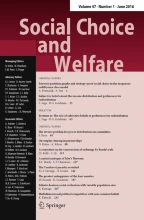Abstract
Assume that players strictly rank each other as coalition partners. We propose a procedure whereby they “fall back” on their preferences, yielding internally compatible, or coherent, majority coalition(s), which we call fallback coalitions. If there is more than one fallback coalition, the players common to them, or kingmakers, determine which fallback coalition will form. The first player(s) acceptable to all other members of a fallback coalition are the leader(s) of that coalition. The effects of different preference assumptions—particularly, different kinds of single-peakedness—on the number of coherent coalitions, their connectedness, and which players become kingmakers and leaders are investigated. The fallback procedure may be used (i) empirically to identify kingmakers and leaders or (ii) normatively to select them. We illustrate the model using data from the U.S. Supreme Court, 2005–2009.
Similar content being viewed by others
References
Brams SJ (2008) Mathematics and democracy: designing better voting and fair division procedures. Princeton University Press, Princeton
Brams SJ, Camilo G, Franz AD (2012) Coalition formation on the U.S. supreme court, 1969–2009. Public Choice (forthcoming)
Brams SJ, Jones MA, Kilgour DM (2002) Single-peakedness and disconnected coalitions. J Theor Politics 14(3): 359–383
Brams SJ, Jones MA, Kilgour DM (2005) Forming stable coalitions: the process matters. Public Choice 125(1–2): 67–94
Brams SJ, Kilgour DM (2001) Fallback bargaining. Group Decis Negot 10(4): 287–316
Edelman PH, Chen J (2007) The most dangerous justice rides into the sunset. Const Comment 24(1): 199–219
Kaniovski S, Leech D (2009) A behavioral power index. Public Choice 141(1–2): 17–29
Liptak A (2009) Roberts court shifts right, tipped by Kennedy. New York Times, New York (June 30)
Liptak A (2010) Court under Roberts is most conservative in decades. New York Times, New York (July 24)
Martin AD, Quinn KM (2002) Dynamic ideal point estimation via Markov Chain Monte Carlo for the U.S. Supreme Court, 1953–1999. Political Anal 10(2): 134–153
Naurin, D, Wallace, H (eds) (2008) Unveiling the Council of the European Union. Games Governments Play in Brussels. Palgrave Macmillan, New York
Riker WH (1962) The theory of political coalitions. Yale University Press, New Haven
Stearns ML (2008) Standing at the crossroads: the Roberts court in hstorical perspective. Notre Dame Law Rev 83(3): 875–963
Toobin J (2008) The nine: inside the secret world of the Supreme Court. Anchor, New York
Author information
Authors and Affiliations
Corresponding author
Rights and permissions
About this article
Cite this article
Brams, S.J., Kilgour, D.M. Kingmakers and leaders in coalition formation. Soc Choice Welf 41, 1–18 (2013). https://doi.org/10.1007/s00355-012-0680-4
Received:
Accepted:
Published:
Issue Date:
DOI: https://doi.org/10.1007/s00355-012-0680-4
